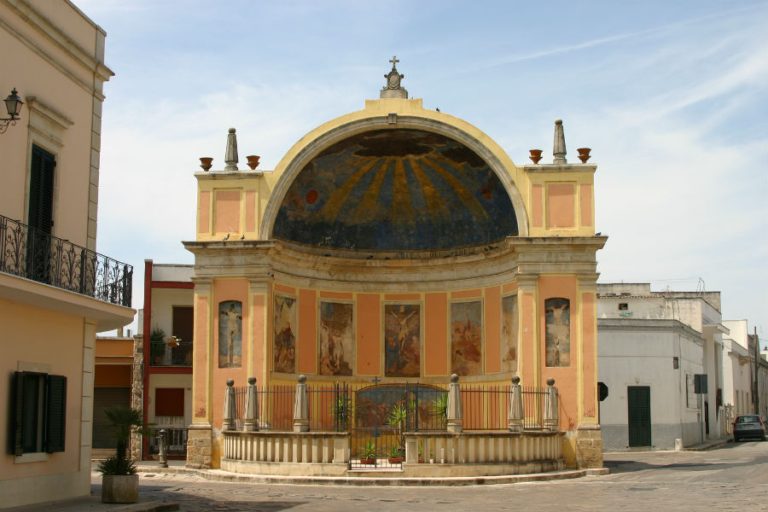The Calvary of Montesano Salentino, built in 1870 along the main road axis that connects the mother church to the ancient sanctuary of San Donato, is a religious monument of great prominence and suggestion. Conceived as the apse of a hypothetical open-air church, it uses the street as the nave, the facades of the buildings as side wings and the sky as the vault, creating a symbolic architecture that transforms urban space into a place of meditation.
Commissioned by archpriest Don Isidoro Marra and Donato Bitonti, with the generosity of the faithful as an inscription recovered during restoration attests, the calvary was built by master builder Silvano Lecci, a descendant of a historic family of local masons. The structure, harmonious and inspired by the exedra of Bramante’s Belvedere, looks like an apsidal aedicule of Doric order, with a high base, pairs of pilasters bordering two side niches with images of the thieves, and an entablature supporting a crowning with pinnacles and terracotta vases.
The roof of the apse is covered with trichrome glazed terracotta scales, probably made by workshops in Lucugnano. An elegant fence with leccese stone balustrade and wrought-iron grating with lance motifs, typical of Salento calvaries, protects the sacred area. The materials used – carparo for the masonry and leccese stone for the carved details – are those traditional to the Salento area.
The pictorial decorations were entrusted in 1873 to master Giuseppe Bottazzi of Diso, an artist trained at the Academy of Fine Arts in Naples and known for his sacred works. Bottazzi painted with the mezzo fresco technique five scenes of the Sorrowful Mysteries of the Rosary: the Prayer in the Garden, the Flagellation, the Coronation of Thorns, the Going to Calvary and, in the center, the Crucifixion with the Virgin, St. John and Mary Magdalene, according to a theatrical composition designed to emotionally involve the faithful.
Montesano’s Calvary is not only a work of popular devotion but also an emblematic example of 19th-century architectural eclecticism, which draws on Renaissance models as a symbol of identity and cultural cohesion in post-unification Italy. The pictorial setting, with realistic and symbolic elements – such as the two thieves, the leaden sky illuminated by the Sun and the Moon – creates a true outdoor sacred representation, capable of evoking the drama of the Passion of Christ every year during the rites of Holy Week.


